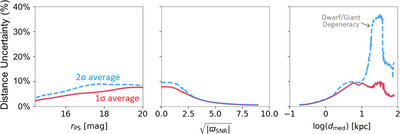Image Details

Caption: Figure 6.
Estimates of the statistical distance uncertainties (i.e., excluding systematic uncertainties) as a function of Pan-STARRS r-band magnitude (r PS; left), parallax S/N (middle), and median estimated distance (right). These are estimated using the distribution of random distance realizations around the median distance estimates, with results from half the width of the 68% credible interval (“1σ average;” solid red) and a quarter the width of the 95% credible (“2σ average;” dashed blue). We find typical uncertainties of 8%–10% at the faintest magnitudes and lowest parallax S/Ns, with uncertainties derived from the 95% confidence intervals (CIs) larger than those derived from the 68% CIs. These differences can become particularly pronounced at larger distances (right panel) due to possible degeneracies between nearby dwarf (main-sequence) and faraway giant (post-main-sequence) stellar evolutionary solutions.
Copyright and Terms & Conditions
© 2024. The Author(s). Published by the American Astronomical Society.












